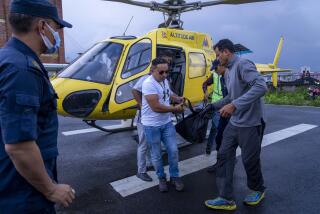Everest Gets Smaller
- Share via
The 1933 event created worldwide news. Royal Air Force pilot David McIntyre and the Scottish marquess of Clydesdale, flying two open-cockpit Westland aircraft, became the first to fly over the summit of 29,035-foot Mt. Everest, the highest point in the world. Climbers did not reach that point until 1953.
There were headlines again in 1991, with the first hot air balloon flight over Everest.
But there was barely a ripple in mid-May when a French helicopter actually landed on the summit of Mt. Everest and then took off, twice. Helicopters are far more limited than airplanes at high altitudes because they depend on the bite of rotors for their lift, a more difficult feat in such thin air. The previous altitude record for a helicopter landing, also set in the Himalayas, was 25,150 feet, according to the Indian air force.
The Eurocopter Ecureuil AS350 B3 used in the record-setting landing is described on a website promoting sightseeing flights in the Himalayas as “the sports car of the rotor world.” So much about the Himalayan experience has been tourist-ized that perhaps “sports car” trips to Everest’s peak were inevitable. What next? With helicopter tours of the Himalayan flanks already well-established tourist events, will brushing the summit become the ultimate for the well-heeled?
Too many climbers, particularly those who pay up to $65,000 to be shepherded to the peak, already take unwarranted risks. Will they now also expect a helicopter to pluck them from the peak if there’s trouble? Let’s hope not. Many injuries and deaths on Everest, including a 1996 tragedy that killed eight, happen during severe weather that would keep any aircraft grounded.
The landing feat may be celebrated as a technical achievement. It also signals another likely diminishment of the ultimate wild spot of the world.
More to Read
Sign up for The Wild
We’ll help you find the best places to hike, bike and run, as well as the perfect silent spots for meditation and yoga.
You may occasionally receive promotional content from the Los Angeles Times.





